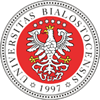Proszę używać tego identyfikatora do cytowań lub wstaw link do tej pozycji:
http://hdl.handle.net/11320/18331Pełny rekord metadanych
| Pole DC | Wartość | Język |
|---|---|---|
| dc.contributor.author | Sosnowski, Michał | - |
| dc.date.accessioned | 2025-07-03T06:51:24Z | - |
| dc.date.available | 2025-07-03T06:51:24Z | - |
| dc.date.issued | 2024 | - |
| dc.identifier.citation | Studia Sieci Uniwersytetów Pogranicza, T. 8, 2024, s. 222-244 | pl |
| dc.identifier.issn | 2544-5790 | - |
| dc.identifier.uri | http://hdl.handle.net/11320/18331 | - |
| dc.description.abstract | Goal – This study aims to analyse value-added tax (VAT) as a key component of state tax revenue, focusing on factors influencing fiscal efficiency. It examines VAT’s performance in EU countries from 2008 to 2021 by analysing the relationship between VAT Total Tax Liability (VTTL) receipts and GDP and comparing these with the VAT Revenue Ratio (VRR) to identify the VAT collection gap. Research methodology – The study is based on a quantitative and descriptive approach, using primary and secondary data from Eurostat, OECD, and the European Commission to analyse VAT performance between 2008 and 2021. The analysis focuses on key variables such as VTTL and VRR relative to GDP to assess VAT efficiency and the collection gap. Descriptive statistics methods are applied to identify trends in VAT revenues and compare fiscal efficiency across EU Member States. Score/results – The analysis reveals that VAT revenues showed significant fluctuations over the period, influenced by the 2007–2009 financial crisis and the COVID-19 pandemic. Despite these disruptions, VAT remained a stable source of tax revenue in EU countries, with Southern and Eastern Europe showing larger VAT gaps than Northern and Western Europe. Originality/value – This study contributes to the understanding of VAT as a fiscal instrument, highlighting its role in stabilizing public finances and adapting to macroeconomic conditions. Its findings are valuable for policymakers aiming to enhance the resilience of VAT systems during economic crises. | pl |
| dc.language.iso | en | pl |
| dc.publisher | Wydawnictwo Uniwersytetu w Białymstoku | pl |
| dc.subject | fiscal policy | pl |
| dc.subject | indirect tax | pl |
| dc.subject | VAT | pl |
| dc.subject | VRR | pl |
| dc.subject | VTTL | pl |
| dc.subject | VAT gap | pl |
| dc.title | Fiscal Efficiency of VAT in the EU Countries | pl |
| dc.type | Article | pl |
| dc.rights.holder | © Copyright by Uniwersytet w Białymstoku, Białystok 2024 | pl |
| dc.identifier.doi | 10.15290/sup.2024.08.16 | - |
| dc.description.Email | michal.sosnowski@ue.wroc.pl | pl |
| dc.description.Affiliation | Wroclaw University of Economics and Business | pl |
| dc.description.references | Acosta-Ormaechea S., Morozumi A., 2019, The Value Added Tax and Growth: Design Matters, “Discussion Papers”, No. 4. | pl |
| dc.description.references | Aizenman J., Jinjarak Y., 2008, The Collection Efficiency of the Value Added Tax: Theory and International Evidence, “The Journal of International Trade & Economic Development”, Vol. 17, No. 3. | pl |
| dc.description.references | Arnold M.J., 2011, Tax Policy for Economic Recovery and Growth, “The Economic Journal”, No. 121. | pl |
| dc.description.references | Barbone L., Bonch-Osmolovskiy M., Poniatowski G., 2015, Study to Quantify and Analyse the VAT Gap in the EU Member States, CASE Network Reports, No. 124, https://ssrn.com/abstract=2693524 [date of access: 14.02.2024]. | pl |
| dc.description.references | Besley T., Persson T., 2011, Pillars of Prosperity, [in:] Pillars of Prosperity, Princeton. | pl |
| dc.description.references | Besley T., Persson T., 2014, Why Do Developing Countries Tax So Little?, “Journal of Economic Perspectives”, No. 28(4). | pl |
| dc.description.references | Brondolo J., 2009, Collecting Taxes during an Economic Crisis: Challenges and Policy Options, IMF Staff Position Note, SPN/09/17, Washington. | pl |
| dc.description.references | Brzeziński B., Dębowska-Romanowska T., Kalinowski M., Wójtowicz W., 1997, Prawo finansowe, 2nd ed., Warszawa. | pl |
| dc.description.references | Cnossen S., 2022, The C-Inefficiency of the EU-VAT and What Can Be Done about It, “Int Tax Public Finance”, No. 29, DOI: 10.1007/s10797-021-09683-0. | pl |
| dc.description.references | Durović-Todorović J., Dorđević M., Ristić M., 2019, C-Efficiency Ratio as A Measure of Vat Efficiency in EU Developing Countries and Serbia, “Novi Ekonomist”, No. 13(26). | pl |
| dc.description.references | Dziemianowicz R., Budlewska R., 2022, VAT Revenues in 2008–2020: Trends and Challenges of COVID-19, “Ekonomia i Prawo”, No. 21(1). | pl |
| dc.description.references | Ebrill, L., Keen M., Perry V., 2001, The Modern VAT, International Monetary Fund, Washington, D.C., DOI: 10.5089/9781589060265.071. | pl |
| dc.description.references | European Commission, 2021, VAT Rules for Financial and Insurance Services, Review, ttps://ec.europa.eu/info/law/better-regulation/have-your-say/initiatives/12671-VAT-rules-for-financial-and-insurance-services-review/public-consultation_en [date of access: 14.02.2024]. | pl |
| dc.description.references | European Commission: Directorate-General for Taxation and Customs Union, 2022, Annual report on taxation 2022 – Tax Policies in the European Union, Publications Office of the European Union, https://data.europa.eu/doi/10.2778/64681 [date of access: 14.02.2024]. | pl |
| dc.description.references | Gendron, P.-P., Bird R.M., 2020, VAT Gaps in Developing Countries: Measurement, Administration and Politics, https://ssrn.com/abstract=3696578 [date of access: 4.08.2024]. | pl |
| dc.description.references | Głuchowski J., 2006, Polskie prawo podatkowe, Warszawa. | pl |
| dc.description.references | Keen M., 2013, The Anatomy of the VAT, “National Tax Journal”, No. 66. | pl |
| dc.description.references | Krajewska A., 2019, Opodatkowanie konsumpcji, pracy i kapitału w krajach Unii Europejskiej, “Gospodarka Narodowa”, No. 298(2), DOI: 10.33119/GN/108610. | pl |
| dc.description.references | Kuzińska H., 2002, Rola podatków pośrednich w Polsce, Warszawa. | pl |
| dc.description.references | Litwińczuk H. (ed.), 2008, Prawo podatkowe przedsiębiorców, Vol. 1, Ed. 6, Warszawa. | pl |
| dc.description.references | Majchrzycka-Guzowska A., 1996, Finanse i prawo finansowe, Warszawa. | pl |
| dc.description.references | Mc Kenzie R.B., 1986, Macroeconomics, Boston. | pl |
| dc.description.references | de Mello L., 2009, Avoiding the Value-added Tax: Theory and Cross-Country Evidence, “Public Finance Review”, Vol. 37, No. 1. | pl |
| dc.description.references | Morrow P., Smart M., Swistak A., 2022, VAT Compliance, Trade, and Institutions, “Journal of Public Economics”, Vol. 208. | pl |
| dc.description.references | Myles, G. D., 2009, Economic Growth and the Role of Taxation-Theory, “OECD Economics Department Working Papers”, No. 713. | pl |
| dc.description.references | OECD, Consumption Tax Trends 2016: VAT/GST and Excise Rates, Trends and Policy Issues, 2016, OECD Publishing, Paris, DOI: 10.1787/ctt-2016-en. | pl |
| dc.description.references | OECD, 2018, Tax Policy Reforms 2018: OECD and Selected Partner Economies, OECD Publishing, Paris, DOI: 10.1787/9789264304468-en. | pl |
| dc.description.references | OECD, 2020, Revenue Statistics 2020, OECD Publishing, Paris, DOI: 10.1787/8625f8e5-en. | pl |
| dc.description.references | OECD, 2021, Tax Policy Reforms 2021: Special Edition on Tax Policy during the COVID-19 Pandemic. OECD Publishing, DOI: 10.1787/427d2616-en. | pl |
| dc.description.references | OECD, 2022, Consumption Tax Trends 2022: VAT/GST and Excise, Core Design Features and Trends, OECD Publishing, Paris, DOI: 10.1787/6525a942-en. | pl |
| dc.description.references | Poniatowski G., Bonch-Osmolovskiy M., Śmietanka A., 2021, VAT Gap in the EU – Report 2021, Publications Office, https://data.europa.eu/doi/10.2778/447556 [date of access: 14.02.2024]. | pl |
| dc.description.references | Sancak C., Velloso R., Xing J., 2010, Tax Revenue Response to the Business Cycle, “IMF Working Paper”, No. 10(71). | pl |
| dc.description.references | Simon H., Harding M., 2020, What Drives Consumption Tax Revenues? Disentangling Policy and Macroeconomic Drivers, OECD, “Taxation Working Papers”, No. 47. | pl |
| dc.description.references | Śmietanka A., Bonch-Osmolovskiy M., Poniatowski G., 2020, Study and Reports on the VAT Gap in the EU-28 Member States – 2020 Final Report, G. Poniatowski (ed.), Publications Office, https://data.europa.eu/doi/10.2778/2517 [date of access: 14.02.2024]. | pl |
| dc.description.references | Ubide A., 2016, The Case for an Active Fiscal Policy in the Developed World, “Business Economics”, Vol. 51(3). | pl |
| dc.description.references | Woodford M., 2010, Financial Intermediation and Macroeconomic Analysis, “Journal of Economic Perspectives”, No. 24(4). | pl |
| dc.description.volume | 8 | pl |
| dc.description.firstpage | 222 | pl |
| dc.description.lastpage | 244 | pl |
| dc.identifier.citation2 | Studia Sieci Uniwersytetów Pogranicza | pl |
| dc.identifier.orcid | 0000-0002-0567-5109 | - |
| Występuje w kolekcji(ach): | Studia Sieci Uniwersytetów Pogranicza, 2024, tom 8 | |
Pliki w tej pozycji:
| Plik | Opis | Rozmiar | Format | |
|---|---|---|---|---|
| SUP_8_2024_M_Sosnowski_Fiscal_Efficiency_of_VAT_in_the_EU_Countries.pdf | 364,2 kB | Adobe PDF | Otwórz |
Pozycja jest chroniona prawem autorskim (Copyright © Wszelkie prawa zastrzeżone)

